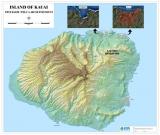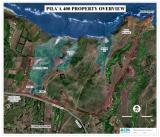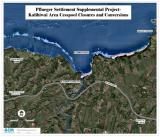Pflueger Clean Water Settlement
The EPA has reached a settlement of over $7.5 million with James Pflueger over Clean Water Act violations associated with construction activities on Pflueger's property in Hawaii. This is the largest storm water settlement in the United States for violations at a single site by a single landowner.
On this page:
Action
The Department of Justice, U.S. Environmental Protection Agency, Hawai'i Department of Health, the Hawaii Attorney General's Office, Kauai County, Earthjustice, the Limu Coalition and Kilauea Neighborhood Association have reached an agreement with James Pflueger (and two related corporate entities, Pflueger Properties and Pila'a 400) over Clean Water Act (CWA) violations associated with construction activities at his properties on the island of Kaua'i, Hawai'i.
Background
This case primarily concerns approximately 378 acres of coastal property owned by James Pflueger at Pila'a on the Island of Kaua'i, Hawai'i . After purchasing this property in 1997, Mr. Pflueger conducted grading, grubbing and other land-disturbing construction activities on various portions of the property without obtaining a Clean Water Act (CWA) storm water National Pollutant Discharge Elimination System (NPDES) permit or a CWA section 404 permit for filling waters. These activities included cutting and filling to create new coastal access roads, carving away a hillside to create a 40 foot vertical road cut adjacent to the coast, building dams in streams to create ponds, and grading a coastal plateau. The environmental consequences of this construction activity include massive discharges of sediment-laden storm water in November, 2001 which flowed to the ocean, damaging a beachfront home and the coral reef. The disturbed areas had none of the erosion control measures in place that are required under the CWA and that would have been required to be implemented through a NPDES storm water permit.
Mr. Pflueger also failed to obtain a CWA storm water permit for his construction activities on property near the Kaloko reservoir, mauka of Pila'a. (See Figure 1.) Measures to control contaminant releases to nearby streams were not taken during this construction on the Kaloko site.
At Pila'a, three perennial coastal streams were impacted by unauthorized placement of soil and rocks as fill material. Part of one stream was filled to construct a coastal access road in the stream bed. Two other streams were impounded to form a series of decorative ponds. These alterations diminished the value of the coastal streams as habitat for native aquatic life, such as o'opu, and damselflies.
Figure 1 Map of Kauai showing location of Pila'a property, Kaloko property, and Kalihiwai.
The settlement resolves multiple enforcement actions taken by federal, state and county agencies, as well as the citizen groups. In December, 2001, the County of Kauai issued a notice of violation to Mr. Pflueger for unauthorized work in a Special Management Area. In 2002, EPA Region 9 and the Hawai'i Department of Health issued orders for violations of the CWA. Also, in 2002, a CWA citizen suit was filed by Earthjustice on behalf of local community organizations, the Limu Coalition and Kilauea Neighborhood Association.
Based on plans approved by EPA and the other parties to this settlement, in September 2004 Mr. Pflueger began to stabilize particularly vulnerable areas of the Pila'a property to reduce the ongoing erosion risks .
There are related State enforcement actions against James Pflueger for his activities at Pila'a. In May 2005 Mr. Pflueger pleaded guilty to ten felony counts in Hawai'i state criminal court and was ordered to pay a $500,000 penalty. In July 2005 the Hawaii Board of Land and Natural Resources fined Mr. Pflueger $4 Million for natural resource damages associated with sediment runoff and its damage to the beach and coral reef at Pila'a.
Settlement Provisions
Payment of Penalties: As a result of the CWA violations described above, under the settlement, Mr. Pflueger will pay fines totaling $2 Million to the State of Hawai'i and to the United States . This represents the largest CWA stormwater penalty for violations at a single site, by a single landowner, in the United States .
Injunctive Relief : In order to repair damage caused by Mr. Pflueger's unauthorized construction, work valued at approximately $5.3 Million is required under the settlement. The primary components of this work are overall site stabilization to prevent further erosion and restoration of stream segments at three sites on the property. (See Figure 2.)
Figure 2 . Aerial overview of Pila'a property showing locations of Gulch 2, Gulch 3, Pila'a Stream, and Eastern Plateau where stabilization and restoration work will be done.
Site Stabilization - Under the settlement, work will continue to stabilize portions of the property vulnerable to erosion. This will include completion of a soil "nail wall" to stabilize a 40-foot cliff adjacent to the Pila'a Bay shoreline. Erosion control will be maintained on roadways and trails that are used on the property. Terracing slopes, and planting and maintaining vegetation cover will be used to control erosion at other sites, including a barren ridge at the eastern shoreline of Pila'a Bay. For all required vegetation, the settlement requires the control of invasive plant species and use of native trees and shrubs.
On the Kaloko site, stabilization measures are being constructed and vegetation planted to control storm water runoff from the site. This work is scheduled to be completed in October 2006.
Stream Restoration - Under the settlement, channel restoration will be done in the three streams that were modified by Mr. Pflueger.
Gulch 2 - In this stream, Mr. Pflueger built an access road over parts of a stream and installed a culvert to redirect the stream. Restoration activities are designed to return the stream to its natural state. The access road will be removed. Establishing native plants along the stream is a component of the restoration. This work is scheduled to be completed in March, 2007.
Gulch 3 - Mr. Pflueger filled portions of this stream by constructing dams and installing PVC outlet pipes to create a series of seven ornamental ponds. Under the settlement, three dams will be removed, thus eliminating three ponds. The original stream bed will be reconstructed, restoring this part of the stream to its natural state. At the upper four ponds, the PVC conduits will be removed, and dams will be lowered so that the ponds are smaller and the stream flows on the surface between the ponds. Native plants will be established along the stream as part of the restoration work, which is scheduled to be completed in October, 2007.
Pila'a Stream - Mr. Pflueger's construction activities included construction of a dam which created a new lake in Pila'a Stream. Under the settlement, sediment from this lake will be removed, and the streambed will be reconstructed to restore it to its natural state. Revegetation with native plants will be part of the Pila'a Stream restoration, which is scheduled to be completed in August, 2007.
All work on these waterways will be followed by monitoring of stream conditions and vegetation to ensure that performance criteria in the consent decree have been met.
Supplemental Environmental Project: In addition, Mr. Pflueger will implement a Supplemental Environmental Project to improve the environment in a beach community near Pila'a Bay. In this project, Mr. Pflueger will spend approximately $200,000 to replace cesspools used for wastewater disposal at individual homes located near the beach in Kalihiwai. (See Figure 3.) These wastewater improvements will make the water in Kalihiwai Stream and Bay safer for swimmers.
Figure 3 . Aerial photo showing Kalihiwai beach and stream where cesspool closures and coversions will be done as a Supplemental Environmental Project.
Significance
This Consent Decree, the first combined Federal, State, County and citizen environmental enforcement action in Hawaii, represents a significant deterrent to others who disregard Federal, State, and local permit and erosion control requirements. It is a landmark settlement with $2 Million penalty, the largest CWA storm water penalty imposed to date in the United States for a single site and single landowner, including extensive repair and restoration work costing approximately $5.3 Million, and a supplemental environmental project for $200,000.
This settlement will reduce erosion at Pila'a, restore perennial stream systems, including surrounding native plant habitats, and will lead to cleaner safer streams and coastal waters, as well as healthier reefs.
For additional information, contact:
Tom Charlton
U.S. EPA
1200 Pennsylvania Avenue, NW (2243A)
Washington, DC 20460
(202) 564-6960
charlton.tom@epa.gov



